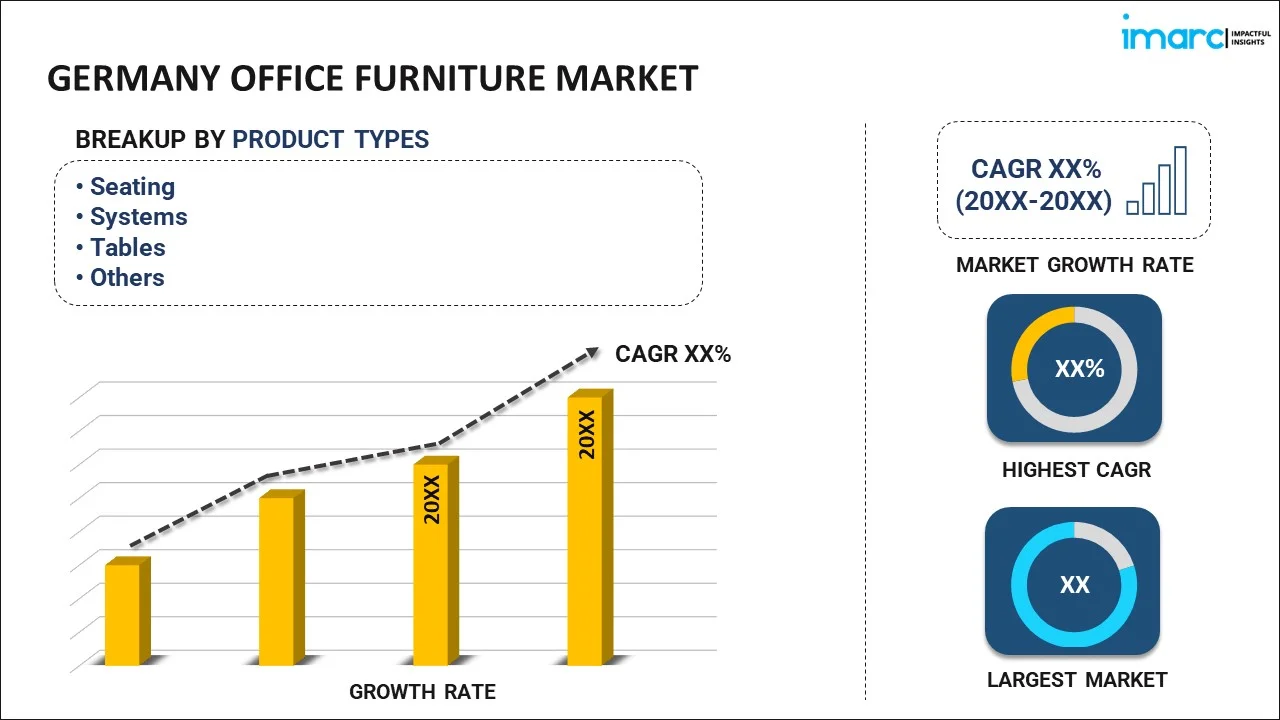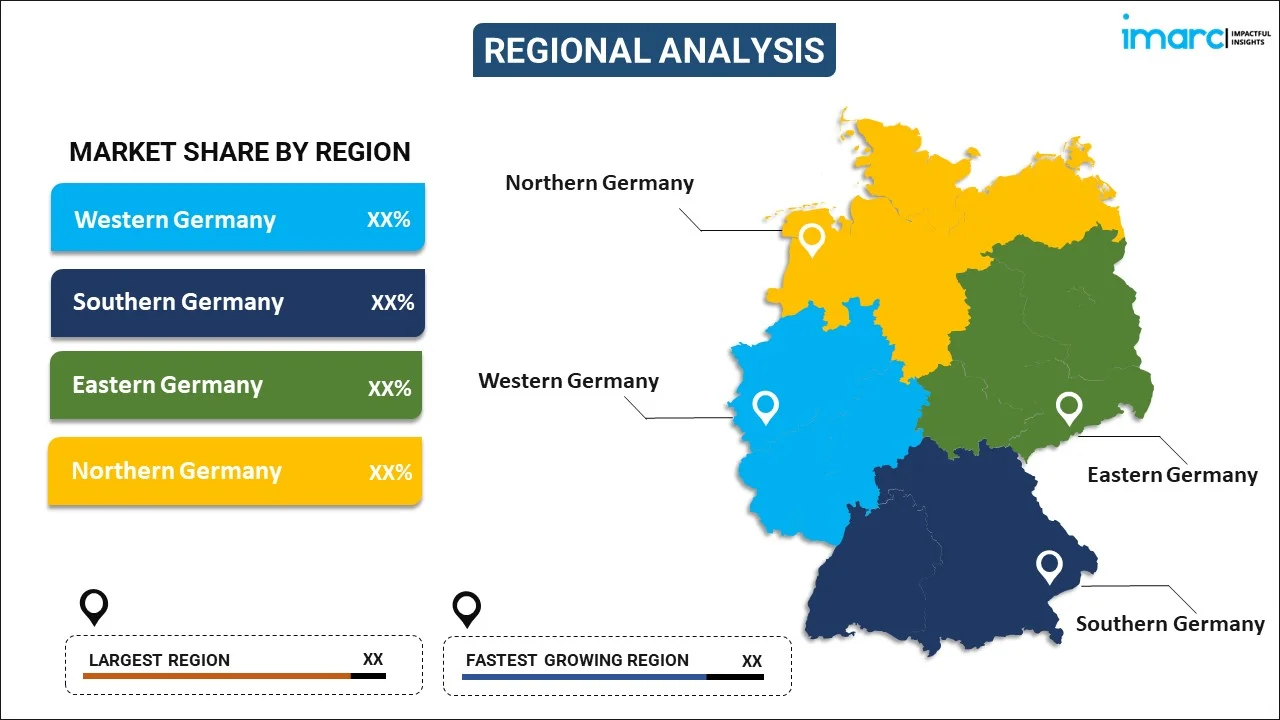
Germany Office Furniture Market Report by Product Type (Seating, Systems, Tables, Storage Units and File Cabinets, Overhead Bins, and Others), Material Type (Wood, Metal, Plastic and Fiber, Glass, and Others), Distribution Channel (Offline, Online), Price Range (Low, Medium, High), and Region 2025-2033
Germany Office Furniture Market Overview:
The Germany office furniture market size is projected to exhibit a growth rate (CAGR) of 2.11% during 2025-2033. Technological advancements, ergonomic design trends, sustainability initiatives, changing work culture, escalating demand for home offices, flexible working arrangements, the expansion of commercial spaces, emphasis on employee well-being, and integration of smart features are some of the factors fueling the market growth.
|
Report Attribute
|
Key Statistics
|
|---|---|
|
Base Year
|
2024 |
|
Forecast Years
|
2025-2033 |
|
Historical Years
|
2019-2024
|
| Market Growth Rate (2025-2033) | 2.11% |
Germany Office Furniture Market Trends:
Technological Advancements:
In the office furniture market in Germany, global technological advancements are changing traditional roles and connections between furniture and its users. The Internet of Things (IoT) enabled furniture and smart office solutions are growing in importance, enabling a new level of connectivity and functionality within workspaces. IoT-based furniture incorporates sensors and actuators to collect data for automating different activities improving the user experience, as well as productivity. These intelligent systems also assist in modifying lighting, temperature, as well as the preferred seating options as per user requirements and environmental conditions thus resulting in a more comfortable and productive workspace. Furthermore, smart office solutions also cover a variety of technologies such as cloud-based management software and mobile applications that enable users to remotely access or manage their workspace.
Ergonomic Design Trends:
German companies are placing a growing focus on the health of employees, and this is reflected in the latest ergonomic design trends that are influencing what firms will be purchasing for their offices in the future. It is important to note that ergonomically designed furniture has been made with the ultimate purpose of maximizing comfort and minimizing physical stress. This heightens operational output because it helps reduce failure among employees such as musculoskeletal disorders for instance. Manufacturers are introducing ergonomic chairs that can be adjusted for lumbar support, armrests, and seat height in order to address these trends. And the development of adjustable workstations and desks that can be raised and lowered to allow users to stand while working are providing an impetus to the market growth.
Sustainability Initiatives:
Sustainability initiatives are driving significant changes in the German office furniture market, with a growing emphasis on eco-friendly materials and manufacturing processes. As environmental concerns continue to escalate, businesses are increasingly prioritizing sustainability in their purchasing decisions, opting for furniture made from recycled or renewable materials such as wood, metal, and plastic. Manufacturers are also adopting energy-efficient production methods and reducing waste to minimize their environmental impact. Moreover, sustainable certifications such as Forest Stewardship Council (FSC) and Leadership in Energy and Environmental Design (LEED) are becoming increasingly important criteria for businesses when selecting office furniture suppliers.
Germany Office Furniture Market News:
- In 2024: Fnatic, UK-based esports organization, entered into a strategic partnership with the furniture manufacturer Steelcase. This collaboration is aimed at enhancing the ergonomic environment for Fnatic’s players, creators, and staff throughout Europe. Steelcase, renowned for its focus on workplace well-being and productivity, will supply Fnatic with its line of gaming chairs designed for comfort and performance.
- In 2024: Herman Miller partnered with Rifyo to make a significant impact in Indonesia’s evolving design landscape. The company is poised to contribute to the district’s ethos of innovation and design excellence while providing a curated experience for visitors seeking premium and authentic design solutions.
Germany Office Furniture Market Segmentation:
IMARC Group provides an analysis of the key trends in each segment of the market, along with forecasts at the country level for 2025-2033. Our report has categorized the market based on product type, material type, distribution channel, and price range.
Product Type Insights:

- Seating
- Systems
- Tables
- Storage Units and File Cabinets
- Overhead Bins
- Others
The report has provided a detailed breakup and analysis of the market based on the product type. This includes seating, systems, tables, storage units and file cabinets, overhead bins, and others.
Material Type Insights:
- Wood
- Metal
- Plastic and Fiber
- Glass
- Others
A detailed breakup and analysis of the market based on the material type have also been provided in the report. This includes wood, metal, plastic and fiber, glass, and others.
Distribution Channel Insights:
- Offline
- Direct Sales
- Specialist Store
- Non-Specialist Stores
- Others
- Online
The report has provided a detailed breakup and analysis of the market based on the distribution channel. This includes offline sales (direct sales, specialist stores, non-specialist stores, and others) and online.
Price Range Insights:
- Low
- Medium
- High
A detailed breakup and analysis of the market based on the price range have also been provided in the report. This includes low, medium, and high.
Region Insights:

- Western Germany
- Southern Germany
- Eastern Germany
- Northern Germany
The report has also provided a comprehensive analysis of all the major regional markets, which include Western Germany, Southern Germany, Eastern Germany, and Northern Germany.
Competitive Landscape:
The market research report has also provided a comprehensive analysis of the competitive landscape. Competitive analysis such as market structure, key player positioning, top winning strategies, competitive dashboard, and company evaluation quadrant has been covered in the report. Also, detailed profiles of all major companies have been provided.
Germany Office Furniture Market Report Coverage:
| Report Features | Details |
|---|---|
| Base Year of the Analysis | 2024 |
| Historical Period | 2019-2024 |
| Forecast Period | 2025-2033 |
| Units | Billion USD |
| Scope of the Report | Exploration of Historical Trends and Market Outlook, Industry Catalysts and Challenges, Segment-Wise Historical and Future Market Assessment:
|
| Product Types Covered | Seating, Systems, Tables, Storage Units and File Cabinets, Overhead Bins, Others |
| Material Types Covered | Wood, Metal, Plastic and Fiber, Glass, Others |
| Distribution Channels Covered |
|
| Price Ranges Covered | Low, Medium, High |
| Regions Covered | Western Germany, Southern Germany, Eastern Germany, Northern Germany |
| Customization Scope | 10% Free Customization |
| Post-Sale Analyst Support | 10-12 Weeks |
| Delivery Format | PDF and Excel through Email (We can also provide the editable version of the report in PPT/Word format on special request) |
Key Questions Answered in This Report:
- How has the Germany office furniture market performed so far and how will it perform in the coming years?
- What has been the impact of COVID-19 on the Germany office furniture market?
- What is the breakup of the Germany office furniture market on the basis of product type?
- What is the breakup of the Germany office furniture market on the basis of material type?
- What is the breakup of the Germany office furniture market on the basis of distribution channel?
- What is the breakup of the Germany office furniture market on the basis of price range?
- What are the various stages in the value chain of the Germany office furniture market?
- What are the key driving factors and challenges in the Germany office furniture?
- What is the structure of the Germany office furniture market and who are the key players?
- What is the degree of competition in the Germany office furniture market?
Key Benefits for Stakeholders:
- IMARC’s industry report offers a comprehensive quantitative analysis of various market segments, historical and current market trends, market forecasts, and dynamics of the Germany office furniture market from 2019-2033.
- The research report provides the latest information on the market drivers, challenges, and opportunities in the Germany office furniture market.
- Porter's five forces analysis assist stakeholders in assessing the impact of new entrants, competitive rivalry, supplier power, buyer power, and the threat of substitution. It helps stakeholders to analyze the level of competition within the Germany office furniture industry and its attractiveness.
- Competitive landscape allows stakeholders to understand their competitive environment and provides an insight into the current positions of key players in the market.
Need more help?
- Speak to our experienced analysts for insights on the current market scenarios.
- Include additional segments and countries to customize the report as per your requirement.
- Gain an unparalleled competitive advantage in your domain by understanding how to utilize the report and positively impacting your operations and revenue.
- For further assistance, please connect with our analysts.
 Inquire Before Buying
Inquire Before Buying
 Speak to an Analyst
Speak to an Analyst
 Request Brochure
Request Brochure
 Request Customization
Request Customization




.webp)




.webp)












